Iron Bioaccessibility and Speciation in Microalgae Used as a Dog Nutrition Supplement
Abstract
:Simple Summary
Abstract
1. Introduction
2. Materials and Methods
2.1. In Vitro Digestion
2.2. Iron Detection and Bioaccessibility
2.3. Extraction of Soluble Proteins
2.4. Iron Speciation after Size Exclusion Chromatography (SEC)
2.5. Statistical Analysis
3. Results and Discussion
3.1. Iron Content in Microalgae
3.2. Iron Bioaccessibility
3.3. Iron Speciation and Protein Fractioning Using Size Exclusion Chromatography (SEC)
4. Conclusions
Author Contributions
Funding
Institutional Review Board Statement
Informed Consent Statement
Data Availability Statement
Conflicts of Interest
References
- Safi, C.; Zebib, B.; Merah, O.; Pontalier, P.Y.; Vaca-Garcia, C. Morphology, composition, production, processing and applications of Chlorella vulgaris: A review. Renew. Sustain. Energy Rev. 2014, 35, 265–278. [Google Scholar] [CrossRef]
- Mendes, M.C.; Navalho, S.; Ferreira, A.; Paulino, C.; Figueiredo, D.; Silva, D.; Gao, F.; Gama, F.; Bombo, G.; Jacinto, R.; et al. Algae as food in europe: An overview of species diversity and their applications. Foods 2022, 11, 1871. [Google Scholar] [CrossRef]
- Niccolai, A.; Zittelli, G.C.; Rodolfi, L.; Biondi, N.; Tredici, M.R. Microalgae of interest as food source: Biochemical composition and digestibility. Algal Res. 2019, 42, 101617. [Google Scholar] [CrossRef]
- Wang, G.; Shen, S.; Niu, J.; Zhu, D.; Li, J. An economic assessment of astaxanthin production by large scale cultivation of Haematococcus pluvialis. Biotechnol. Adv. 2011, 29, 568–574. [Google Scholar] [CrossRef]
- Yang, R.; Wei, D.; Xie, J. Diatoms as cell factories for high-value products: Chrysolaminarin, eicosapentaenoic acid, and fucoxanthin. Crit. Rev. Biotechnol. 2020, 40, 993–1009. [Google Scholar] [CrossRef]
- Sandgruber, F.; Gielsdorf, A.; Baur, A.C.; Schenz, B.; Muller, S.M.; Schwerdtle, T.; Stang, G.I.; Griehl, C.; Lorkowski, S.; Dawczynski, C. Variability in macro- and micronutrients of 15 commercially avaiable microalgae powders. Mar. Drugs 2021, 19, 310. [Google Scholar] [CrossRef]
- Nass, P.P.; Nascimento, T.C.; Fernandes, A.S.; Caetano, P.A.; de Rosso, V.V.; Jacob-Lopes, E.; Zepka, L.Q. Guidance for formulating ingredients/products from Chlorella vulgaris and Arthrospira platensis considering carotenoid and chlorophyll bioaccessibility and cellular uptake. Food. Res. Int. 2022, 157, 111469. [Google Scholar] [CrossRef]
- Pauline, T.; Lieu, M.H.; Peterson, A.; Yang, Y. The roles of iron in health and disease. Mol. Asp. Med. 2001, 22, 1–87. [Google Scholar] [CrossRef]
- Puyfoulhoux, G.; Rouanet, J.M.; Besancon, P.; Baroux, B.; Baccou, J.C.; Caporiccio, B. Iron availability from iron-fortified spirulina by an in vitro digestion/Caco-2 cell culture model. J. Agric. Food Chem. 2001, 49, 1625–1629. [Google Scholar] [CrossRef]
- Principe, M.V.; Permigiani, I.S.; Della Vedova, M.C.; Petenatti, E.; Pacheco, P.; Gil, R.A. Bioaccessibility studies of Fe, Cu and Zn from Spirulina dietary supplements with different excipient composition and dosage form. J. Pharm. Pharmacogen. Res. 2020, 8, 422–433. [Google Scholar]
- Nakano, S.; Takekoshi, H.; Nakano, M. Chlorella pyrenoidosa supplementation reduces the risk of anemia, proteinuria and edema in pregnant women. Plant. Food. Hum. Nutr. 2010, 65, 25–30. [Google Scholar] [CrossRef] [PubMed]
- Muszynska, B.; Krakowska, A.; Lazur, J.; Jekot, B.; Zimmer, L.; Szewczyk, A.; Sulkowska-Ziaja, K.; Poleszak, E.; Opoka, W. Bioaccessibility of phenolic compounds, lutein, and bioelements of preparations containing Chlorella vulgaris in artificial digestive juices. J. Appl. Phycol. 2017, 30, 1629–1640. [Google Scholar] [CrossRef] [PubMed]
- De Medeiros, V.P.B.; de Souza, E.L.; de Albuquerque, T.M.R.; da Costa Sassi, C.F.; dos Santos Lima, M.; Sivieri, K.; Pimentel, T.C.; Magnani, M. Freshwater microalgae biomasses exert a prebiotic effect on human colonic microbiota. Algal Res. 2021, 60, 102547. [Google Scholar] [CrossRef]
- Jin, J.B.; Cha, J.W.; Shin, I.S.; Jeon, J.Y.; Cha, K.H.; Pan, C.H. Supplementation with Chlorella vulgaris, Chlorella protothecoides, and Schizochytrium sp. increases propionate-producing bacteria in in vitro human gut fermentation. J. Sci. Food Agric. 2020, 100, 2938–2945. [Google Scholar] [CrossRef]
- Delsante, C.; Pinna, C.; Sportelli, F.; Dalmonte, T.; Stefanelli, C.; Vecchiato, C.G.; Biagi, G. Assessment of the effects of edible microalgae in a canine gut model. Animals 2022, 12, 2100. [Google Scholar] [CrossRef]
- Case, L.P.; Daristotle, L.; Hayek, M.G.; Raasch, M. Canine and Feline Nutrition: A Resource for Companion Animal Professionals, 3rd ed.; Elsevier Health Sciences: Amsterdam, The Netherlands, 2010. [Google Scholar]
- McCown, J.L.; Specht, A.J. Iron homeostasis and disorders in dogs and cats: A review. J. Am. Anim. Hosp. Assoc. 2011, 47, 151–160. [Google Scholar] [CrossRef]
- Geiger, U. Regenerative anemias caused by blood loss or hemolysis. In Textbook of Veterinary Internal Medicine, 6th ed.; Elsevier: Amsterdam, The Netherlands, 2005; pp. 1886–1907. [Google Scholar]
- Ristic, J.M.; Stidworthy, M.F. Two cases of severe iron-deficiencyanaemia due to inflammatory bowel disease in the dog. J. Small Anim. Pract. 2002, 43, 80–83. [Google Scholar] [CrossRef]
- Biagi, G.; Cipollini, I.; Grandi, M.; Pinna, C.; Vecchiato, C.G.; Zaghini, G. A new in vitro method to evaluate digestibility of commercial diets for dogs. Ital. J. Anim. Sci. 2016, 15, 617–625. [Google Scholar] [CrossRef]
- Isani, G.; Niccolai, A.; Andreani, A.; Dalmonte, T.; Bellei, E.; Bertocchi, M.; Tredici, M.R.; Rodolfi, L. Iron speciation and iron binding proteins in Arthrospira platensis grown in media containing different iron concentrations. Int. J. Mol. Sci. 2022, 23, 6283. [Google Scholar] [CrossRef]
- Masha, E.J.; Vetter, T.R. Significance, errors, power, and the sample size: The blocking and tackling of statistics. Anesth. Analg. 2018, 126, 691–698. [Google Scholar] [CrossRef]
- Kejzar, J.; Jagodic, H.M.; Ogrinic, N.; Masten, R.J.; Poklar, U.N. Characterization of algae dietary supplements using antioxidative potential, elemental composition, and stable isotopes approach. Front. Nutr. 2021, 5, 618503. [Google Scholar] [CrossRef] [PubMed]
- Rzymski, P.; Budzulak, J.; Niedzielski, P.; Klimaszyk, P.; Proch, J.; Kozak, L.; Poniedzialek, B. Essential and toxic elements in commercial microalgal food supplements. J. Appl. Phycol. 2019, 31, 3567–3579. [Google Scholar] [CrossRef]
- Maruyama, I.; Nakao, T.; Shigeno, I.; Ando, Y.; Hirayama, K. Application of unicellular algae Chlorella vulgaris for the mass-culture of marine rotifer Brachionus. Hydrobiologia 1997, 358, 133–138. [Google Scholar] [CrossRef]
- Tokosoglu, O.; Unal, M.K. Biomass nutrient profiles of three microalgae: Spirulina platensis, Chlorella vulgaris, and Isochrisis galbana. J. Food Sci. 2003, 68, 1144–1148. [Google Scholar] [CrossRef]
- Panahi, Y.; Pishgoo, B.; Jalalian, H.R.; Mohammadi, E.; Taghipour, H.R.; Sahebkar, A. Investigation of the effects of Chlorella vulgaris as an adjunctive therapy for dyslipidemia: Results of a randomised open-label clinical trial. Nutr. Diet. 2012, 69, 13–19. [Google Scholar] [CrossRef]
- Isani, G.; Bertocchi, M.; Ferlizza, E.; Dalmonte, T.; Fedrizzi, G.; Andreani, G. Iron content, iron speciation and phycocyanin in commercial samples of Arthrospira platensis. Int. J. Mol. Sci. 2022, 23, 13949. [Google Scholar] [CrossRef]
- Rutar, J.M.; Hudobivnik, M.J.; Necemer, M.; Mikus, K.V.; Arcon, I.; Ogrinc, N. Nutritional quality and safety of the Spirulina dietary supplements sold on the slovenian market. Foods 2022, 11, 849. [Google Scholar] [CrossRef]
- Zhao, P.; Gu, W.; Huang, A.; Wu, S.; Liu, C.; Huan, L.; Gao, S.; Xie, X.; Wang, G. Effect of iron on the growth of Phaeodactylum tricornutum via photosynthesis. J. Phycol. 2017, 54, 34–43. [Google Scholar] [CrossRef]
- Castell, C.; Bernal-Bayard, B.; Ortega, J.M.; Roncel, M.; Hervas, M.; Navarro, A.J. The heterologous expression of a plastocyanin in the diatom Phaeodactylum tricornutum improves cell growth under iron-deficient conditions. Physiol. Plant 2020, 171, 277–290. [Google Scholar] [CrossRef]
- Demarco, M.; Moraes, J.O.; Matos, A.P.; Derner, R.B.; Neves, F.F.; Tribuzi, G. Digestibility, bioaccessibility and bioactivity of compounds from algae. Trends Food Sci. Technol. 2022, 121, 114–128. [Google Scholar] [CrossRef]
- The European Pet Food Industry Federation—FEDIAF. Nutritional Guidelines for Complete and Complementary Pet Food for Cats and Dogs; FEDIAF: Brussels, Belgium, 2021. [Google Scholar]
- Uribe-Wandurraga, Z.N.; Igual, M.; Garcia-Segovia, P.; Martinez-Monzo, J. In vitro bioaccessibility of minerals from microalgae-enriched cookies. Food Funct. 2020, 11, 2186–2194. [Google Scholar] [CrossRef] [PubMed]
- Perfiliev, Y.D.; Tambiev, K.; Konnychev, M.A.; Skalny, A.V.; Lobakova, E.S.; Kirpichnikov, M.P. Mössbauer spectroscopic study of transformations of iron species by the cyanobacterium Arthrospira platensis (formerly Spirulina platensis). J. Trace Elem. Med. Biol. 2018, 48, 105–110. [Google Scholar] [CrossRef] [PubMed]
- Mounicou, S.; Szpunar, J.; Lobinski, R. Mettalomics: The concept and methodology. Chem. Soc. Rev. 2009, 38, 1119–1138. [Google Scholar] [CrossRef]
- Ba, F.; Ursu, A.V.; Laroche, C.; Djelveh, G. Haematococcus pluvialis soluble proteins: Extraction, characterization, concentration/fractioning and emulsifying properties. Bioresour. Technol. 2016, 200, 147–152. [Google Scholar] [CrossRef] [PubMed]
- Bermejo, P.; Piñero, E.; Villar, Á.M. Iron-chelating ability and antioxidant properties of phycocyanin isolated from a proteanextract of Spirulina platensis. Food Chem. 2008, 110, 436–444. [Google Scholar] [CrossRef]
- Sutak, R.; Botebol, H.; Blaiseau, P.L.; Léger, T.; Bouget, F.Y.; Camadro, J.M.; Lesuisse, E. A comparative study of iron uptake mechanism in marine microalgae: Iron binding at the cell surface is a critical step. Plant Physiol. 2012, 160, 2271–2284. [Google Scholar] [CrossRef]
- Behnke, J.; Laroche, J. Iron uptake proteins in algae and the role of iron starvation-induced proteins (ISIPs). Eur. J. Phycol. 2020, 55, 339–360. [Google Scholar] [CrossRef]
- Fang, L.; Zhang, J.; Fei, Z.; Wan, M. Chlorophyll as key indicator to evaluate astaxanthin accumulation ability of Haematococcus pluvialis. Bioresour. Bioprocess. 2019, 6, 52. [Google Scholar] [CrossRef]
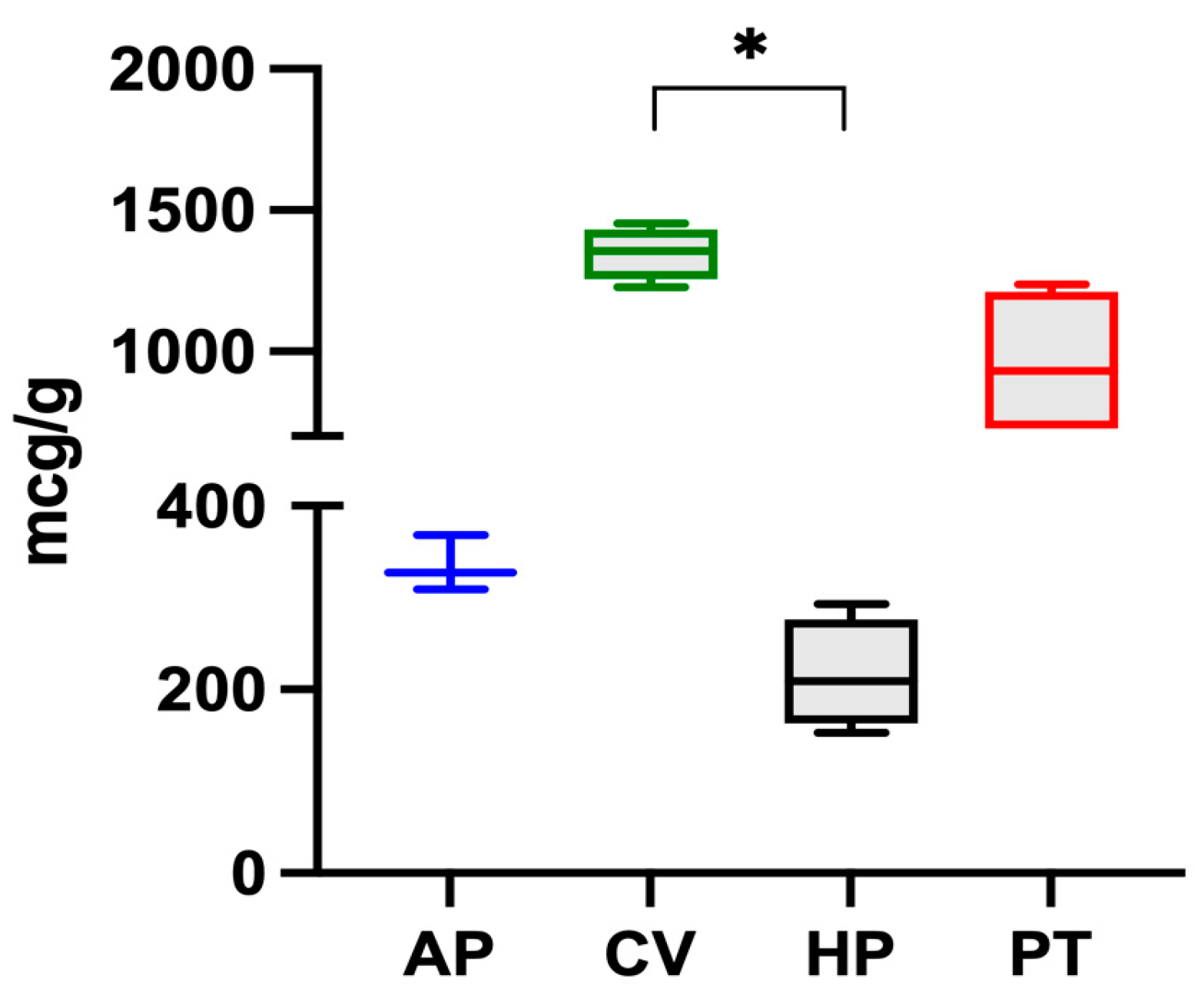
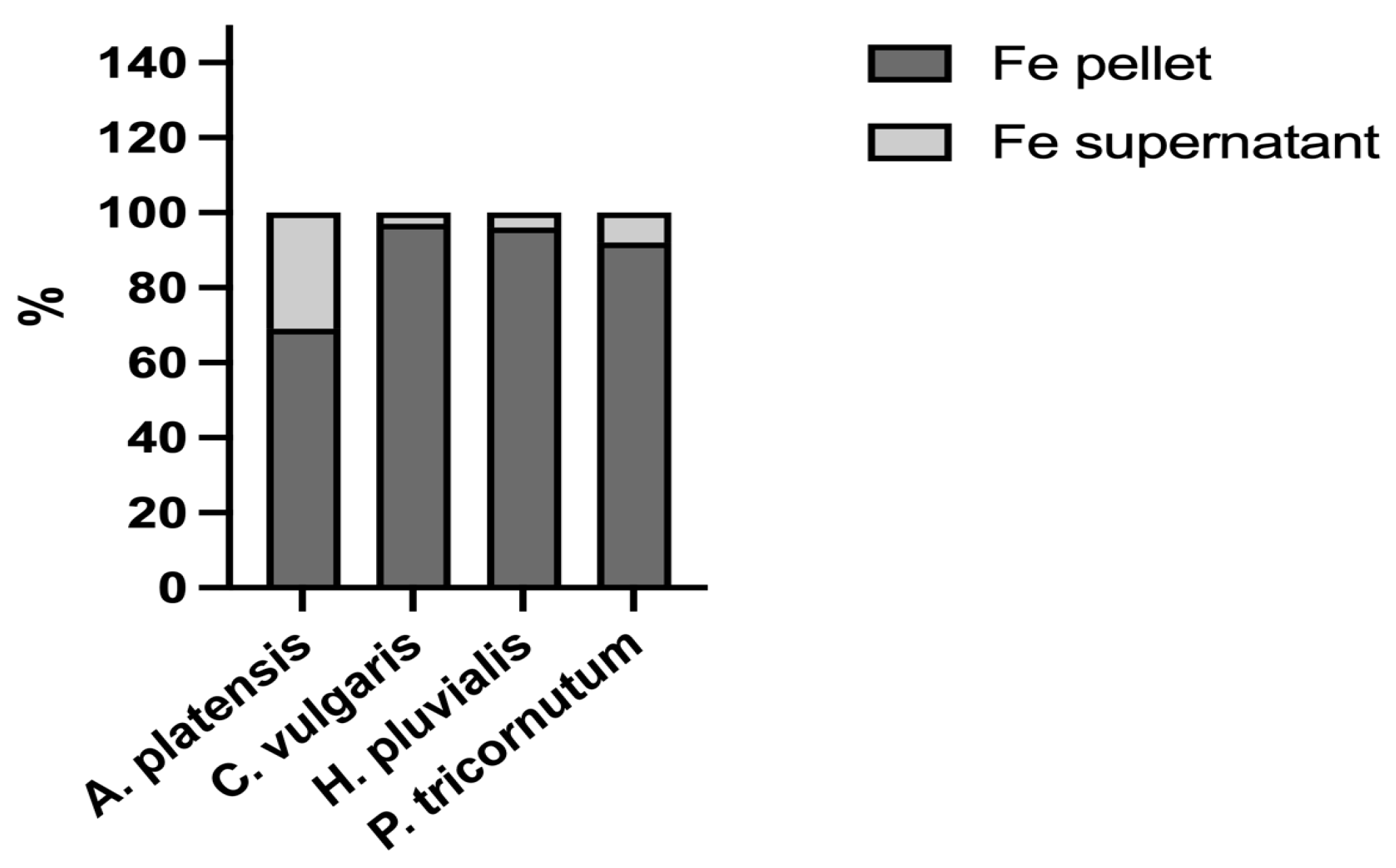

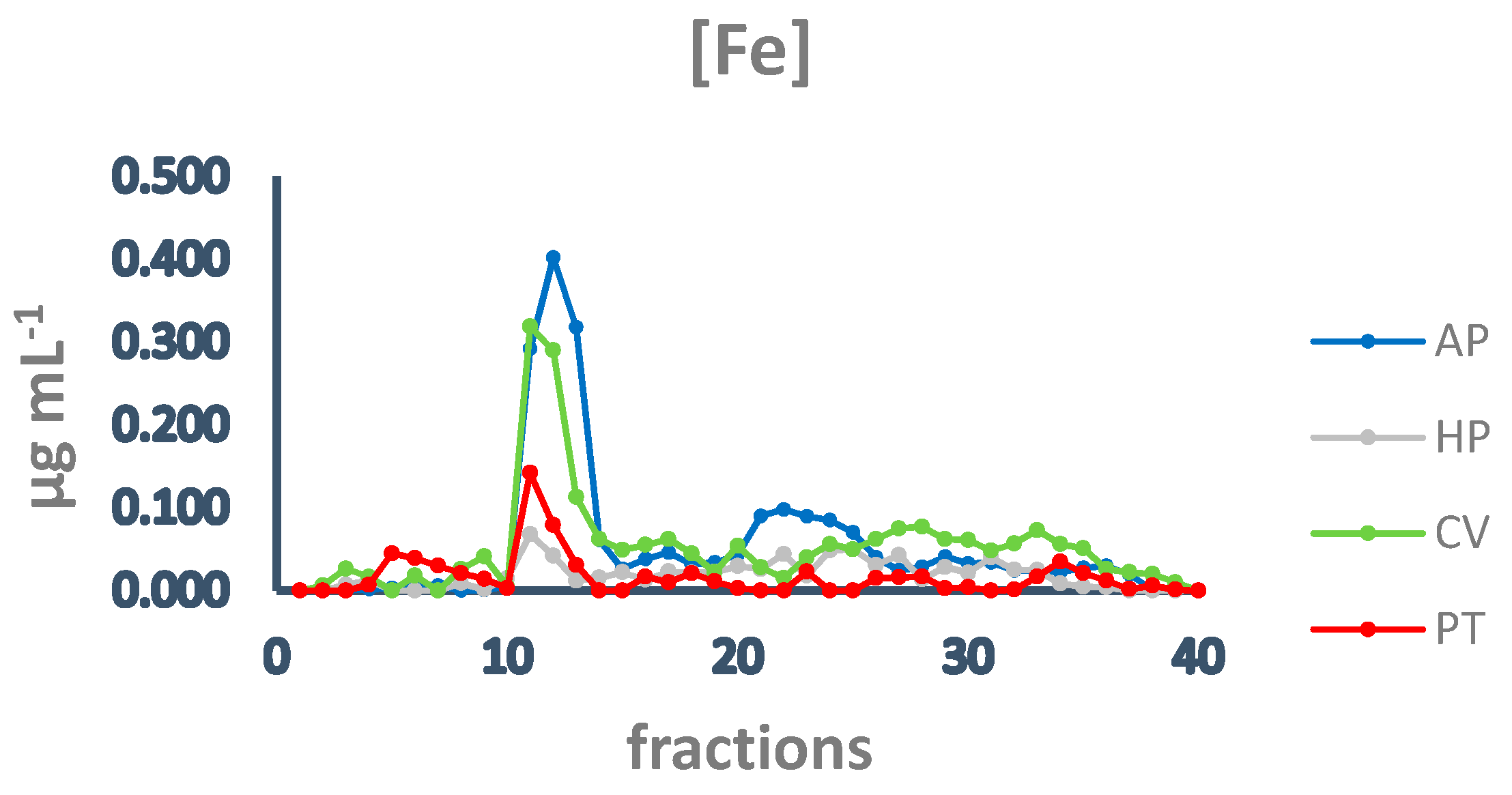
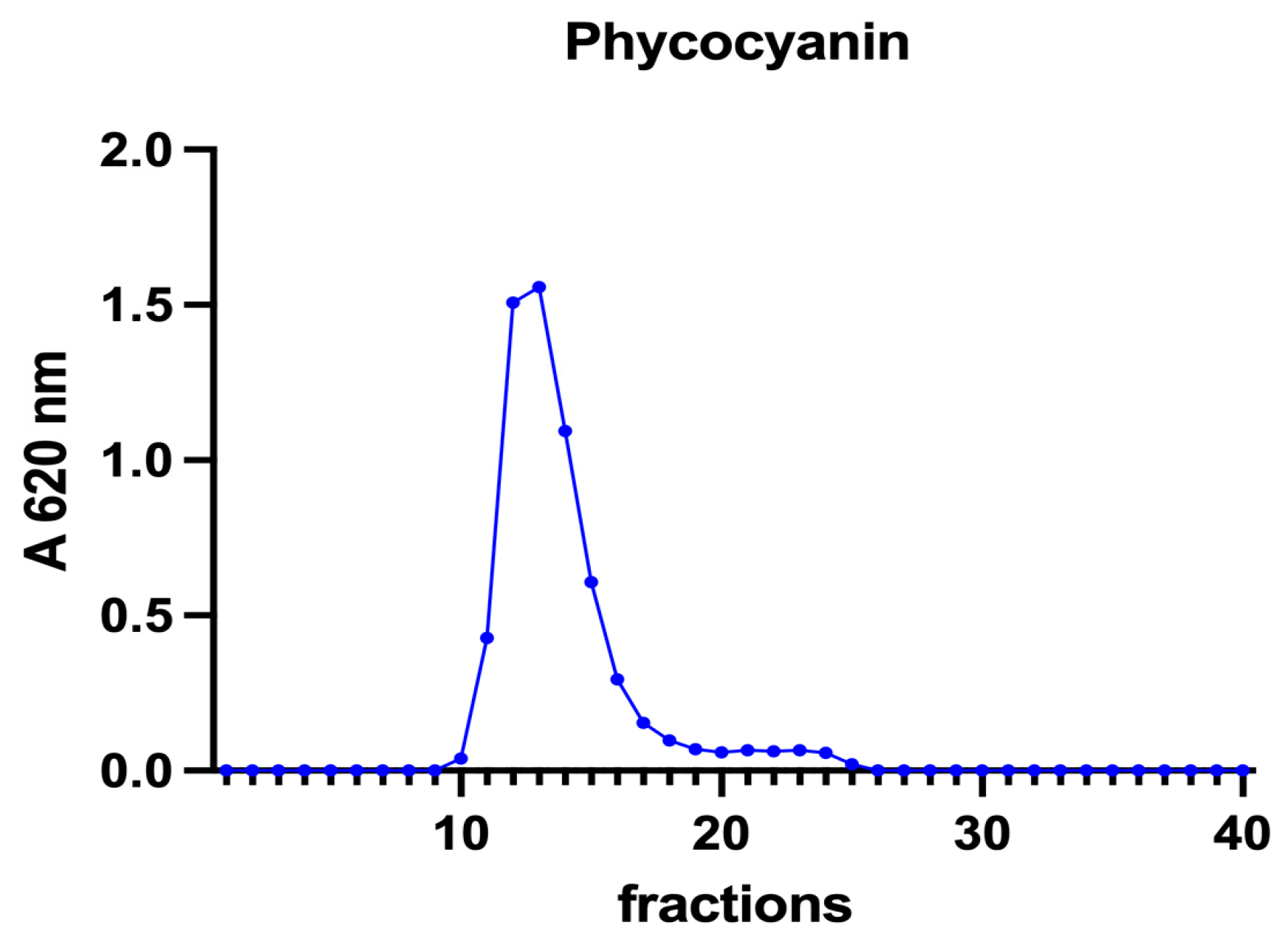
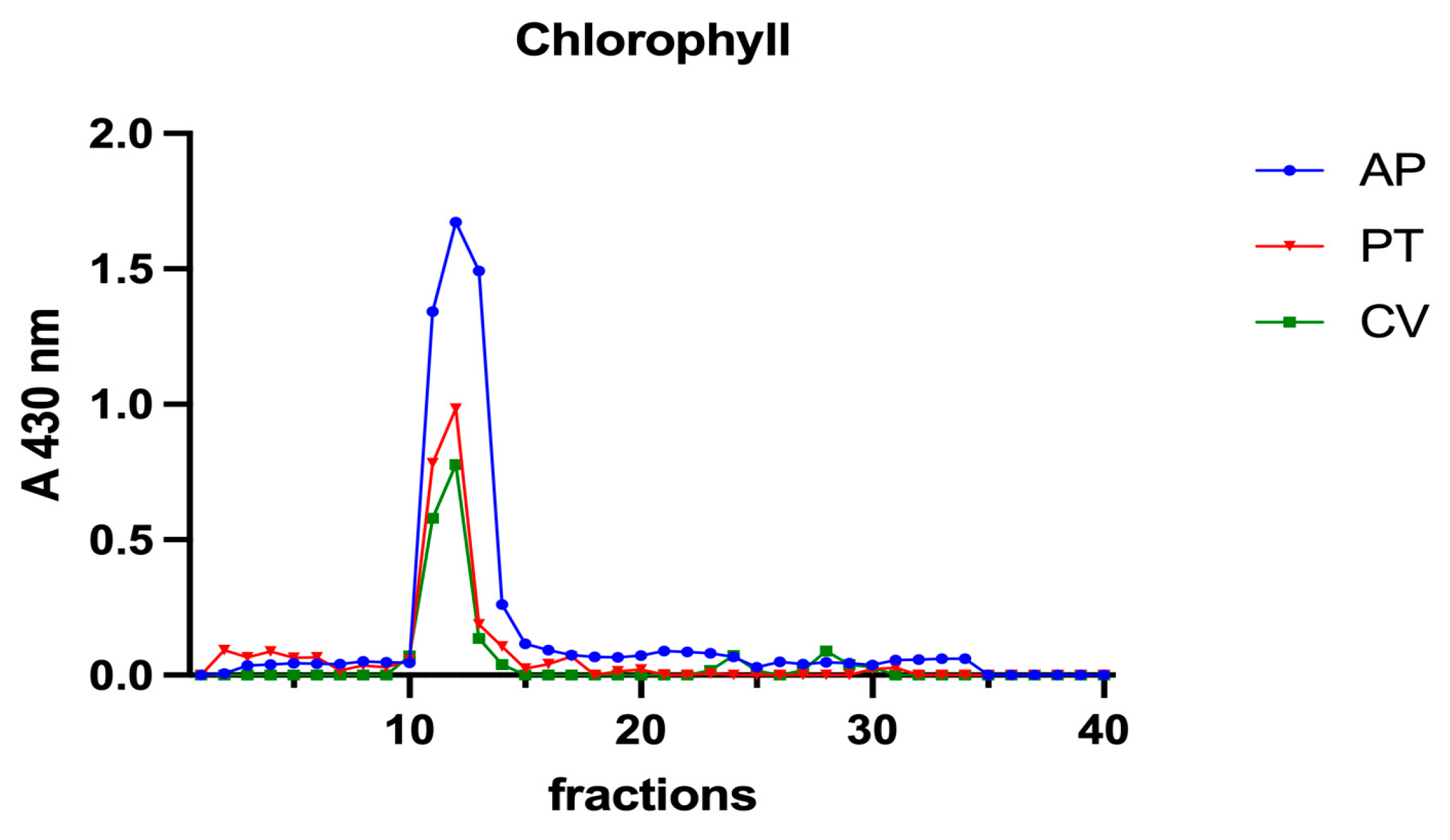
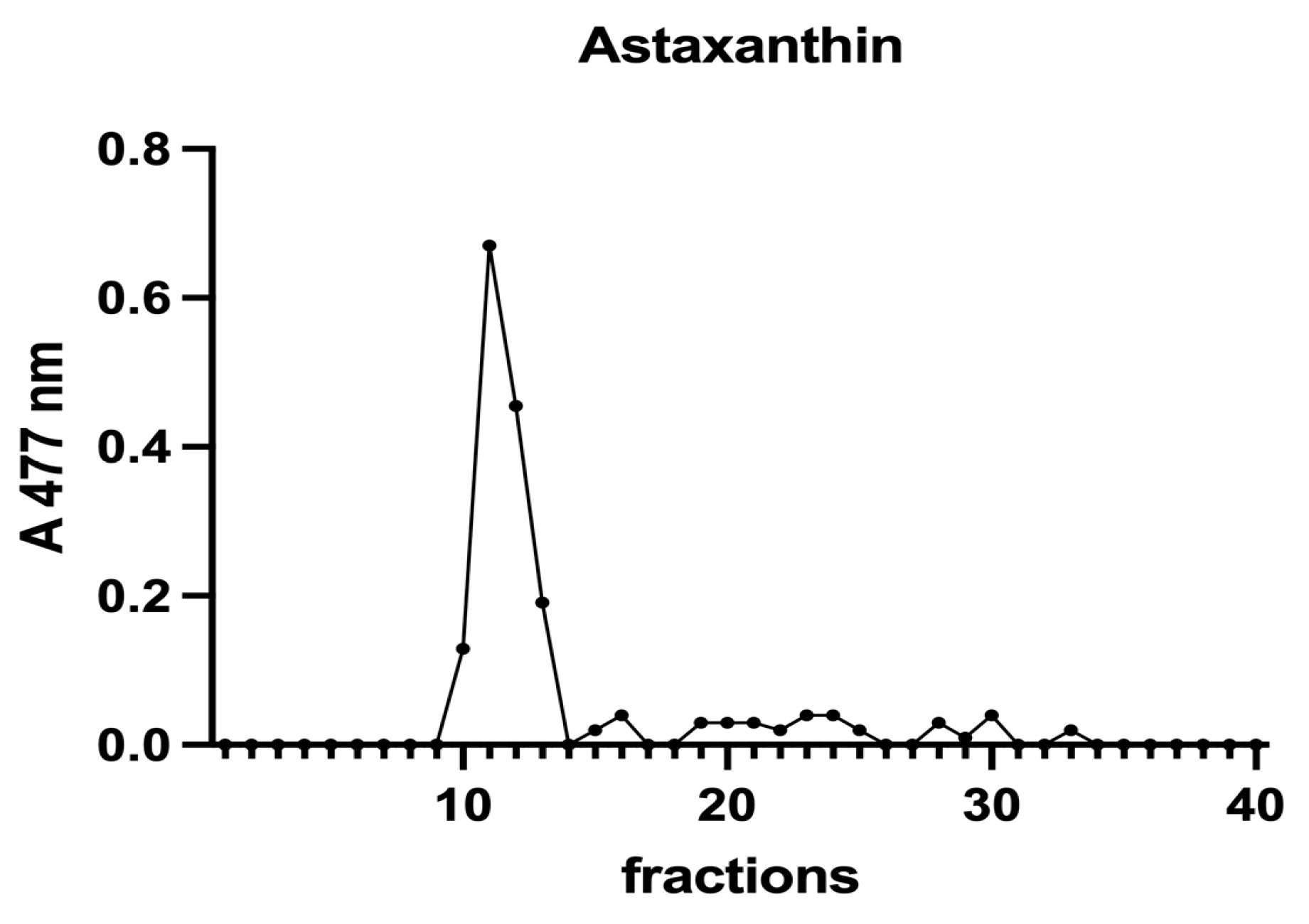
| Algae | Digestibility § (%) | Iron DF * μg mL−1 | Iron UF ° μg g−1 dw | Bioaccessible Fraction % | Bioaccessible Iron μg g−1 alga |
|---|---|---|---|---|---|
| A. platensis | 86 | 1.30 ± 0.43 | 1955 ± 352 b | 31 ± 12 | 104 ± 9 |
| C. vulgaris | 55 | 5.04 ± 2.15 a | 1861 ± 267 | 30 ± 12 | 404 ± 28 c |
| H. pluvialis | 8 | 0.80 ± 0.15 a | 226 ± 49 b | 30 ± 9 | 64 ± 18 c |
| P. tricornutum | 68 | 1.31 ± 0.29 | 1690 ± 70 | 11 ± 0.6 | 105 ± 29 |
Disclaimer/Publisher’s Note: The statements, opinions and data contained in all publications are solely those of the individual author(s) and contributor(s) and not of MDPI and/or the editor(s). MDPI and/or the editor(s) disclaim responsibility for any injury to people or property resulting from any ideas, methods, instructions or products referred to in the content. |
© 2023 by the authors. Licensee MDPI, Basel, Switzerland. This article is an open access article distributed under the terms and conditions of the Creative Commons Attribution (CC BY) license (https://creativecommons.org/licenses/by/4.0/).
Share and Cite
Dalmonte, T.; Vecchiato, C.G.; Biagi, G.; Fabbri, M.; Andreani, G.; Isani, G. Iron Bioaccessibility and Speciation in Microalgae Used as a Dog Nutrition Supplement. Vet. Sci. 2023, 10, 138. https://doi.org/10.3390/vetsci10020138
Dalmonte T, Vecchiato CG, Biagi G, Fabbri M, Andreani G, Isani G. Iron Bioaccessibility and Speciation in Microalgae Used as a Dog Nutrition Supplement. Veterinary Sciences. 2023; 10(2):138. https://doi.org/10.3390/vetsci10020138
Chicago/Turabian StyleDalmonte, Thomas, Carla Giuditta Vecchiato, Giacomo Biagi, Micaela Fabbri, Giulia Andreani, and Gloria Isani. 2023. "Iron Bioaccessibility and Speciation in Microalgae Used as a Dog Nutrition Supplement" Veterinary Sciences 10, no. 2: 138. https://doi.org/10.3390/vetsci10020138





